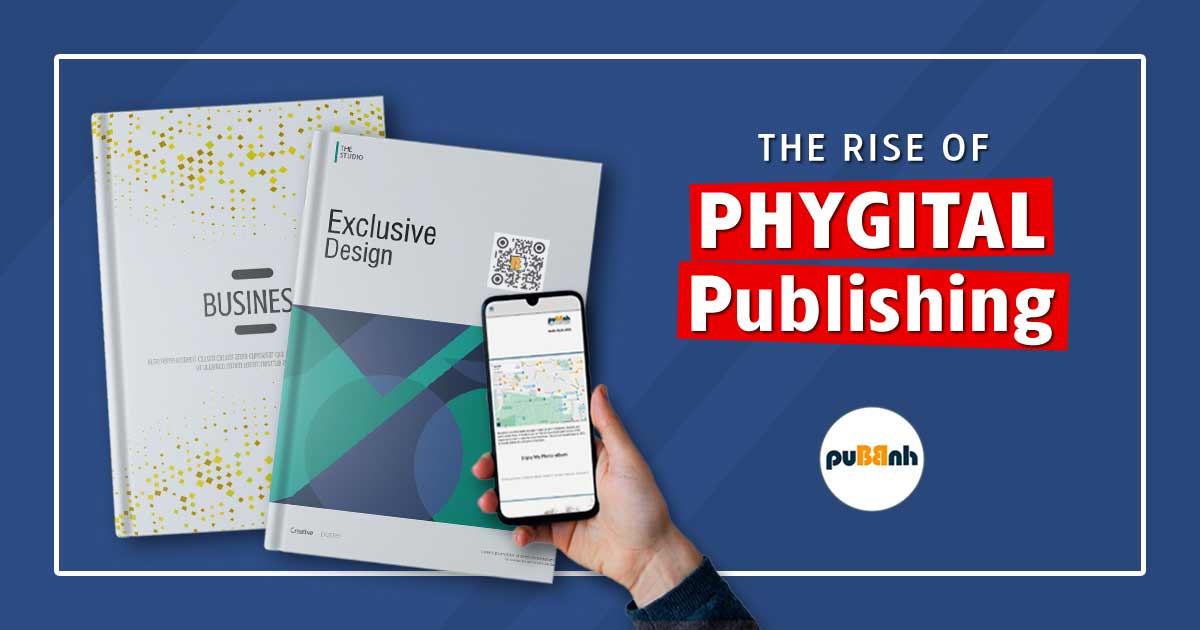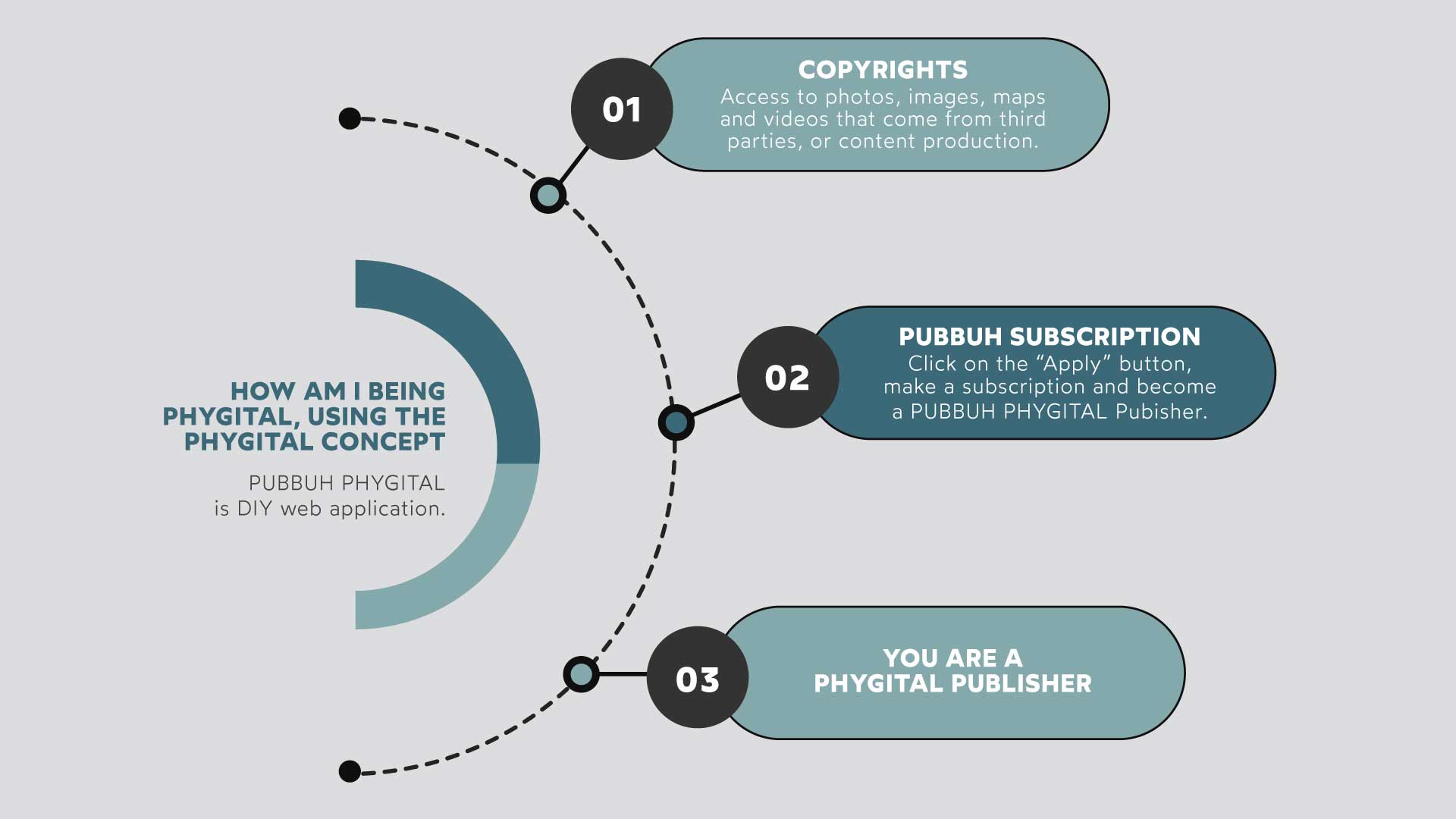Are you familiar with the concept of PHYGITAL marketing?
It is about marketing campaigns running both in physical and digital media. Some experts liken PHYGITAL marketing with engagement marketing!
PHYGITAL comes from the combination of physical and digital actions. This mix leads to engagement and richer experiences for the user.
So, PHYGITAL PUBLISHING is a publishing adaptation of mixing the two realities. We want to offer the publishers a DIY (do it yourself) environment with which they build PHYGITAL books. Imagine printed books that interact with the reader.
The PUBBUH PHYGITAL CONCEPT offers publishers an affordable way to gain valuable insights about their audience. The publishers create a new kind of book (printed or digital) that can interact with the readers.
Later in this story, I am exploring the cost of the PHYGITAL book`s development with and without PUBBUH`s help.

Some facts for the book publishing industry.
The publishing industry is stuck somewhere in the Jurassic era.
The publishing industry as we know it comes from the 15th century when typography spread all over Europe. We are talking about an aged industry. Publishers have built well-defined procedures to do the job. Probably during the centuries, they become inflexible to changes. From this point of view, they are stuck in the past! On the other hand, due to the 21st century, they experience challenges on several levels.
Because of the globalization of the economy and the rise of the Internet, new business models appear. The new economic environment is full of e-shops, e-libraries, e-books, audiobooks, social media, blogs, vlogs, smartphones, tablets, smartwatches, etc. Consumers are everywhere around, not only in bookstores or flea markets.
Furthermore, the people of our century are much more educated. Written words are popular thanks to texting and social media culture. People of the 21st century are well-educated and familiar with texts. However, the publishing industry suffers. This is an antinomy for my thoughts.
What’s happening here?
Did we stop reading because books are boring?
Perhaps reading itself as a habit is no longer so amusing or edutaining. It is time-consuming. We steal hours from our friends. Our friends’ companionship is also anytime and anyplace through social media. Yes, we are still interested to hear about a good story, to experience a great adventure, but this is coming under competition with our available time.
Reading is a solitary process.
Here is a list of the major challenges that publishers of the 21st century take.
- Discoverability: With millions of books available, it can be difficult for new books to stand out and be discovered by potential readers.
- Competition: The market is highly competitive, with many authors and publishers vying for attention and sales.
- Readers’ behavior changed: The rise of digital reading and the decline of physical bookstores have changed the way consumers discover and purchase books.
- Understanding the audience: Reaching the target audience can be challenging, especially for niche or genre-specific books.
- Piracy: Piracy continues to be a major challenge for the book industry, with illegal digital copies of books readily available online.
- Limited marketing budget: Many authors and small publishers have limited marketing budgets, making it difficult to effectively promote their books and reach a wider audience.
Let’s dig deeper into PHYGITAL PUBLISHING and find out if finally it is helpful.
I have to mention that the purpose of adding e-services isn`t to turn the book into a multimedia product. On the contrary, the idea is to enhance the reader’s experience. PHYGITALITY is coming to help the publisher to add some content, services, or interactions that are impossible to use or print on paper. Some services allow users to communicate with each other, or to answer specific questions and give feedback to the publisher.
Of course, the production of a book like that is more expensive. Publishers need to pay for developers, servers, several services, and the list is going on.
This is not the PUBBUH sense. Before we discuss how PUBBUH approaches the costs let`s continue about the benefits of PHYGITAL PUBLISHING.
PHYGITAL uses QR codes, NFC tags, and augmented reality to connect the printed material with the e-content. The reader uses a smartphone or tablet, scans the page and the corresponding service starts running.
Someone somewhere is reading a book. There is more content for this book accessed by the PHYGITAL services. The book reader scans QR codes or NFC codes, then the pictures, videos, and maps appear.
There are a lot of others who read the same book. They can start a forum, a conversation, or comment. The book turns into a node of a social network. The readers are members of this network. They rate the books and the content. They can suggest a title or a gift.
Finally, the publisher is collecting data about the use of the book. They have a better understanding of the audience. They start direct communication with the readers and perhaps suggest new books or even ask them about a new project.
What is the Future of Publishing?
The publishing industry is one of the most fundamental for our culture. Internet, social media, blogs, and text messages allowed written content’s return. Anyone can be an author, an educator, or an influencer. The power of published opinions and stories is irrevocable here.
To understand what has changed in the modern world, we have to start with the traditional role of book publishers.
Every day they are involved in three major tasks:
- Managing copyright contracts, seeking and finding authors, evaluating new content, and exploring new markets.
- It adds value to the content by correcting the language, decorating, and choosing beautiful typography.
- Finally, promote, share, and sell the books to bookstores, and libraries.
The result of the publishing work is to provide the public with high-quality content. Indeed, publishers search and locate content of value, they filter high-quality content from rubbish.
Over the Internet, many different services have developed and changed the environment for publishers. People started blogging, made personal branding with social media, created ebooks, and shared them over bookstores like amazon kindle! The Internet democratizes the publishing process. The cost is that tons of bad content find an easy way out to the public. Concurrently, new services rose. They aimed to discover and reveal fake news, conspiracy theories, pseudoscience, and false content. There is a reverse procedure here; first, we publish and we check later! Of course, this democratizing procedure is good because a lot of good and precious content may never find its way.
The future of publishing is around these concepts: Self Publishing, ebook, audiobook, and digitalization.
Is PHYGITAL publishing part of this new era?
It’s a fair question and we believe yes. People still prefer prints to ebooks. And prints stay alive in many different forms.
From our point of view is a new way to use online services as a material, a canvas to create interesting books. Is a peacemaker for book vs ebook conflict.
PHYGITAL books is a new kind of book. They can exist in printed and digital forms. To make it clear with an example; a book that you read on a kindle device can be PHYGITAL because it is carrying all QR codes or augmenting reality signs.
The author uses the PHYGITAL tools to create a second level of reading. This is the differentiation; the multilevel reading.
How am I being PHYGITAL?
But how and what cost to publish a PHYGITAL book?
There are a lot of different cost resources. I ignore the traditional costs like editing, DTP, or printing. I am concerned here about the costs that are adding up because of the PHYGITAL goal.
For starters, costs’ resources depend on what kind of PHYGITAL features a publisher uses for the book. They classified into five Groups
- Copyrights. Probably content like photos, images, maps, and videos that come from third parties.
- Content Production. If the content is not copyrighted by third parties.
- Software Development. If the book needs some special features.
- Technology. Expenses like web servers, media servers
- Services by third parties. Services like QR campaigns management, NFC tags, Messaging tools, Email campaigns, Analytics
Production could be a low or even zero-budget project. In that case, the book has some QR codes linked with URLs of the publisher’s website.
Is there any value there? Not sure! Probably none. But even with one QR code linked with some extra content some marketing or branding value is produced.
On the other hand, a high-budget project may produce more value for the publisher but I think results in a really bad cost-per-value index.

But now the PUBBUH PHYGITAL CONCEPT is in the game.
We are offering a DIY (Do It Yourself) service which is enough to create PHYGITAL books with a great cost-per-value result.
We have developed all the necessary services a publisher needs:
- A Storytelling system. Publishers create new stories (something similar to blog posts) When a new story is created automatically and is assigned with a QRcode. The publisher can download and use the QR easily.
- PHYGITAL addons. Using this environment the publisher can assign any item on any page of the book to interactions or rich media. All the saved changes are propagated to the prints as well. That happens using the PHYGITAL QRcode. The environment supports several interactions such as video, images, stories, maps, sounds, communication, networking, etc
- PHYGITAL QRcode. When the publisher uploads a new PDF a QRcode is produced. The QR is linked with a web application. Through the application, the reader accesses all the services which are assigned to the book. Furthermore, this application allows the users to communicate with each other about the topics of the book.
- QR codes and NFCs campaigns. The publisher produces and uses more QR codes assigned to services.
- Networking services. The book’s readers may commend or start a conversation about the book`s topics. So each title is a node in a reader’s social network.
- PUBBUH on Action Javascript Library. The publisher may use the library and embed a lot of PHYGITAL services on its website.
PLUS (7)
Newsletter and landing page campaigns. With the use of the storytelling system, you can create landing pages and run email campaigns over your clients` networks.
AND FINALLY (8)
Analytics. Several analytics and statistics are produced. With these insights, you have a better understanding of your books
The PUBBUH PHYGITAL CONCEPT changes the costs of production dramatically. Even if the publisher decides to not assign any interaction the PHYGITAL QRcode is powerful enough and produces value at a minimum cost.

CONCLUSION
PHYGITAL PUBLISHING is a relatively new concept and is still evolving, but it has the potential to revolutionize the publishing industry by offering new and innovative ways to engage with books and other content. The goal of phygital publishing is to create a more engaging and immersive reading experience for users. This approach can also help publishers reach new audiences, particularly younger generations who are increasingly digitally savvy and expect a more interactive and immersive experience.
PUBBUH PHYGITAL CONCEPT is an implementation of PHYGITAL publishing created by the PUBBUH team. Its goal is to offer publishers affordable solutions for the challenges that they take in the 21st century. We achieve this goal by creating an affordable service for the publishers, especially for those with a low budget for marketing actions.